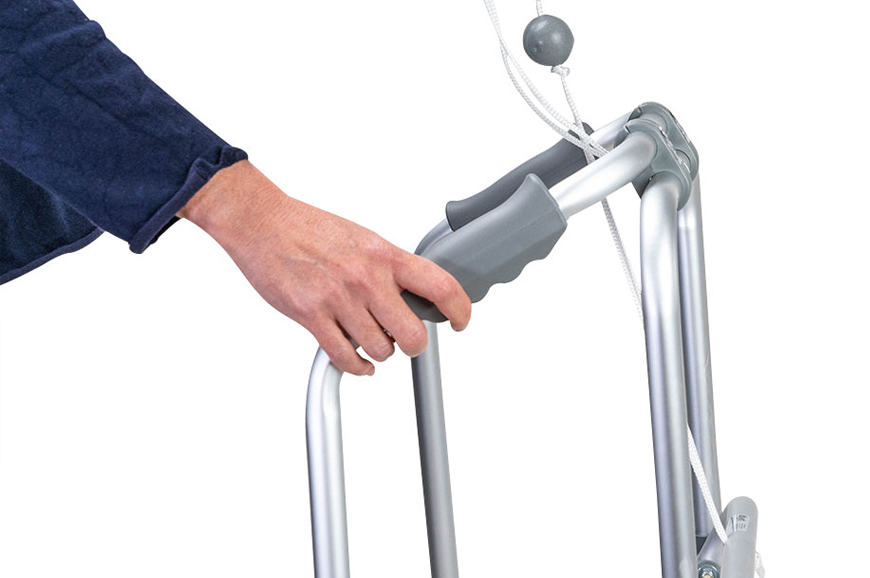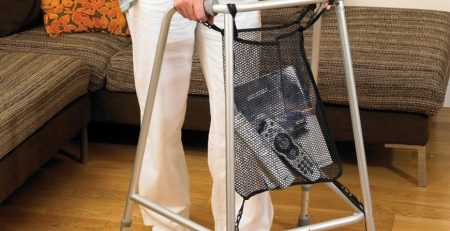- No products in the cart.
What people are a good fit for using a walking frame
Before you determine what is more suitable for your needs (a walking frame or a rollator), it is important to understand what each is and what the main differences are between them. A walking frame — also known as a walker, standard walker, front-wheeled walker, or a rolling walker in some countries — is a more simplistic mobility device than a rollator. Walking frames are lightweight, aluminum structures that have two small wheels on the front legs and pads/grippes on the two rear legs. Walking frames provide mainly balance-related assistance for individuals as they walk through a variety of environments. The main highlight of a walking frame is that it does not have any brakes, which sets it apart from most all other types of mobility devices.
Rollators are completely different pieces of equipment, as they are not only more sleek and stylish (often coming in colors like metallic red or blue) but they also offer more features that simply aren’t available with walking frames. The main highlight of rollators is the presence of hand brakes, but also a fold-down seat that individuals can use to rest while navigating their environment.
Now that you know the basics of these two mobility devices, we will get into the reasons why someone might choose a walking frame as opposed to other mobility devices, such as rollators or canes.
They have good endurance.
As we detailed earlier, walking frames do not have any seating options as rollators do. For this reason, individuals who use walking frames should be able to safely support their body weight at all points in time when walking. They should also have at least average respiratory function, meaning they can independently regulate their breaths and safely find seating when they are becoming fatigued.
They want help regulating their speed.
Walking frames are known to help people control their speed while they ambulate, as rollators are known to be faster devices in general. This is due in part to the presence of four wheels, as opposed to the two on walking frames. Either way, individuals will move a bit slower with walking frames. This is ideal for individuals who have a fear of falling and want the reassurance of a slow, stable device. Most walking frames initially come with plain rubber “shoes” at the base of the rear legs to provide grip and adhere to the floor more. These help give individuals added safety. Some individuals who are a better fit and prefer their walking frame may like it to move a bit more smoothly across surfaces like carpeting and rugs. These individuals can substitute their grippies for small rectangle shaped sliders instead (and switch them back if they find the grips were better). These sliders offer more of a gliding motion over uneven or rough terrain and prevent individuals from needing to lift their walking frame up to pass over the lawn or rugs indoors.
They have good upright posture when walking.
Individuals who use any type of walker should have adequate posture to remain upright while they are walking. This also means they should not be leaning on the walking frame or placing the greater portion of their body weight on the handles. Individuals can certainly use walking frames for support, as this is their main intention. However, some individuals (for example, those with severe osteoporosis, cervical weakness, or other neck and upper back issues) may excessively rely on this mobility device to fully support their bodies when, in fact, it is not safe to do so. Individuals who feel as if they would immediately fall over if their walking frame was not readily available should look into other devices as a means of receiving better mobility assistance. In many cases, healthcare professionals can provide tailored recommendations for mobility devices, as well as individualized rehabilitation plans to strengthen the body and improve posture while walking and completing other daily activities.
Their safety awareness is average.
It has long been thought that individuals who use rollators must have impeccable safety awareness, since they are faster devices that require individuals to judiciously use brakes to get around. While not as much safety awareness is needed to use a walking frame, people who use this mobility device should still demonstrate the capability for being alert and keen to any obstacles or barriers within their environment. They should also be able to safely navigate away from these objects and find an alternative path with good timing, good body posture, and good memory to avoid these same issues in the future. Safety judgment and general cognition are important deciding factors in determining whether or not someone is prepared to safely take charge of their mobility device. (To be clear, there are still mobility devices that are available for people with significantly impaired cognition, such as caregiver-attended transport chairs and wheelchairs.)
They do not need brakes.
As we’ve mentioned before, walking frames do not have brakes, so it is imperative that people using this mobility device are able to safely use their frame without this feature. People who take advantage of the security of walking frames should be able to gauge hazards in their environment, their energy levels, and more to find a place where they can rest or avoid such obstacles to remain safe. Individuals should also be able to avoid unsafe practices such as leaning on their walker in an uneven or risky way, adding unauthorized bags of various weights to the handles, and more. This will help them avoid the need for brakes while remaining in good health. For these reasons and more, individuals should be properly assessed before getting a walking frame to ensure it is a good fit for their needs and lifestyle. This way, individuals will happily be able to use their walking frame anywhere that life takes them.










